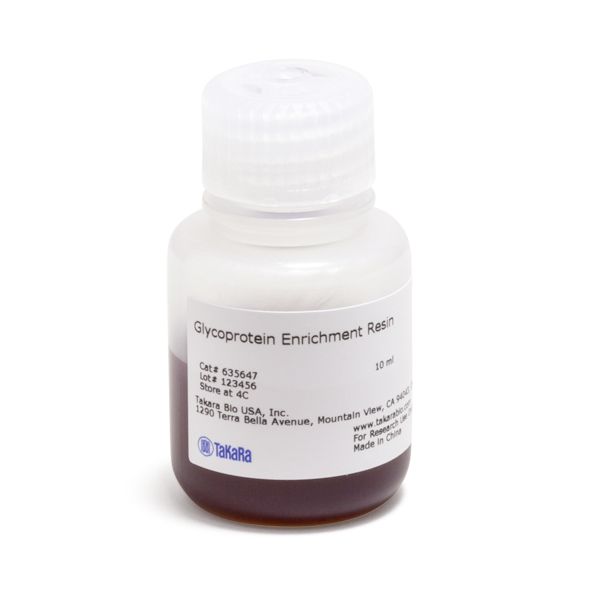Glycoprotein Enrichment Resin
Glycoprotein Enrichment Resin
Our Glycoprotein Enrichment Resin is used for the enrichment of glycosylated proteins from serum, significantly reducing sample complexity in proteomics studies. This phenylboronic acid-based resin, which enriches glycoproteins in 90 min, is supplied in a flexible format for use with either gravity-flow columns or FPLC.
Principle
Glycoprotein Enrichment Resin is a boronic acid-based resin which provides quick, efficient, and specific enrichment of glycoproteins from complex samples such as human serum, using either simple gravity-flow columns or medium pressure methods such as FPLC. The resin consists of an m-aminophenylboronic acid ligand coupled to agarose beads. The ligand binds to cis-diol groups on sugar residues such as mannose, galactose, or glucose that are present within the saccharide moiety of glycoprotein molecules, forming a reversible five-member ring complex. This complex can be dissociated by lowering the pH, or by using an elution buffer containing either Tris or sorbitol.
Overview
- Flexible—enrichment resin can be used with gravity flow or FLPC columns
- Superior performance—enrichment resin shows increased specific binding of glycoproteins and reduced nonspecific binding
- Specific—enrichment resin enriches for low and high-abundance serum glycoproteins
- Fast—enrichment resin enriches glycoproteins in 90 min
Molecular mechanism of saccharide binding to Glycoprotein Enrichment Resin

Molecular mechanism of saccharide binding to Glycoprotein Enrichment Resin.
SDS-PAGE and Western blot analysis of Clontech’s Glycoprotein Enrichment Resin column fractions demonstrate more effective glycoprotein enrichment than a competitor’s resin

SDS-PAGE and Western blot analysis of Clontech’s Glycoprotein Enrichment Resin column fractions demonstrate more effective glycoprotein enrichment than a competitor’s resin. Left panel. Fractions from gravity flow enrichment procedures were analyzed by SDS-PAGE. As seen in the Coomassie-stained gel, the Competitor S Resin showed binding of HSA (human serum albumin) to the column (Lane 6) and leakage of IgG in the flowthrough fraction (Lane 5). Right panel. Fractions from the column were also analyzed by Western blotting with an antibody to human IgG. The Clontech resin retained glycosylated IgG (Lane 3), with no visible loss of IgG in the flowthrough fraction (Lane 2). In contrast, the Competitor S Resin exhibited a loss of IgG in the flowthrough fraction (Lane 5). Lane M: molecular weight marker. Lanes 1, 4: human serum. Lanes 2, 5: flowthrough. Lanes 3, 6: eluate (glycoproteins).
Western blot analysis of column fractions obtained using Clontech’s Glycoprotein Enrichment Resin demonstrates the specific enrichment of high-abundance and low-abundance serum glycoproteins

Western blot analysis of column fractions obtained using Clontech’s Glycoprotein Enrichment Resin demonstrates the specific enrichment of high-abundance and low-abundance serum glycoproteins. Panel A. Specific enrichment of high-abundance serum glycoprotein IgG, detected with an antibody against IgG. Lane 1: human serum, Lane 2: flowthrough, Lane 3: eluate (glycoprotein). Panels B and C: Enriched fractions from the column containing Clontech’s Glycoprotein Enrichment Resin were analyzed by Western blotting with antibodies for two specific low-abundance serum glycoproteins, alpha-1 acid glycoprotein (Panel B) and alpha-1 antitrypsin (Panel C).Lane 1: human serum. Lane 2: eluted fraction. Lane 3: eluted fraction.


